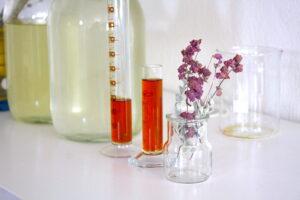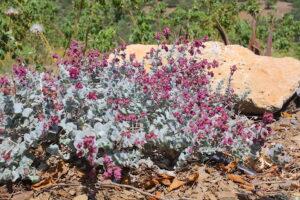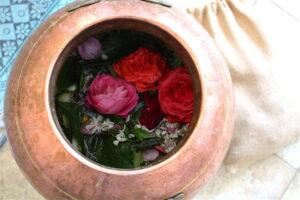Immortelle “symbolises eternal love in the language of flowers, which corroborates the idea of an evolved being with a profoundly spiritual nature.” – describes Philippe Mailhebiau in his valuable Portraits in Oils book.
I finally ultimately fell in love with Helichrysum, also known as Everlasting, when I sniffed it from a bottle presented by a forever young medicine woman at the Botanica conference in Dublin, 2014. The magnificent essential oil was brought along from Slovenia by Jana Eitner, who had a collection of amazing products, and with them the spirit of Gaia, the ancestral mother of all life. During the gala dinner, taking place between the ancient walls of the elegantly majestic 18th century Dining Hall at Trinity College, she was dancing barefoot, free and indigenous, as a rebel fairy could do in a cosy bohemian floral dress.
Portrait
That image somehow, for me perfectly draws the portrait of Immortelle, incorporating its depth, warmth, and eternal light. That character who is being fully grounded, walking on Earth with firm steps, yet embodying resilience. Demonstrates strong inner power, self-confidence and trust in her own abilities, with full awareness of primal capacity and eternal mystery as the essential sources of fundamental energy.

This kind of quality, apart from the original nature of an instinctive, innocent, unspoiled childlike being, is the one of a liberated, mature joy and love of life that carries within sustained learning, wounds acquired, efforts invisible, profound healing, and the ability of forgiveness. Forgiving is a tricky thing, and we tend to roll it up and push it away, with the shield we create to protect ourselves, while cementing hurts and pain. We miss understanding, acceptance and the ability of letting go. And so we miss liberating ourselves through the gentle practice of forgiveness. It may take some time to comprehend this trademarked concept, yet when the time is right, we can comb out and re-evaluate our relationships with others, as well as ourselves. It’s easy finding fault with the outside world. Most people would be yelling their pain out, while also, so many mutely keep crying inside. Struggling quietly, often unconsciously. And even within a lifetime, we tend to switch between these strategies. Yet, the real deal is when we take responsibility for the actual work of processing pain, and ready to embark upon the ceremony of forgiving and letting go.
Helichrysum italicum with a sort of omnipotence, is a wonderfully holistic aromatic herb with a strong ability of supporting one on the emotional-spiritual level. Looking at its potency within the spectrum of healing power for the physical body, helichrysum is one of the strongest with pretty tangible therapeutic effects. Literally, its extremely strong anti-inflammatory, wound-healing and regenerating properties are something to experience on our own skin, although the treats extend to areas deeper beyond the large organic surface of the human body.
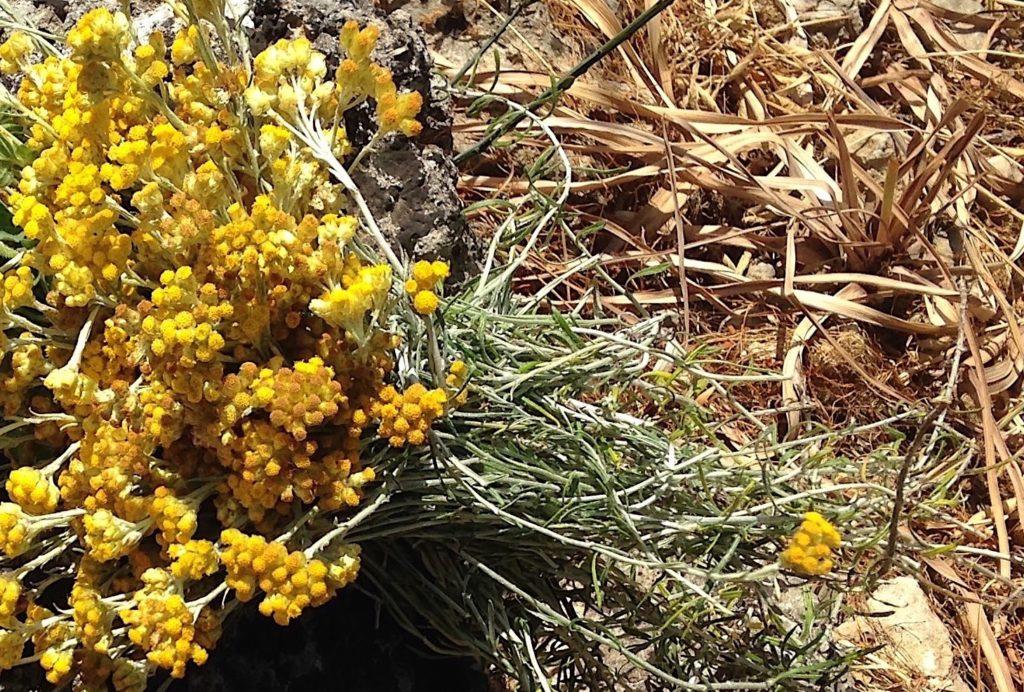
So, as you see, I keep switching on how to address this beautiful plant that is variably known as Everlasting, Immortelle, or Helichrysum. Whichever we tend to refer to, I think we can agree that the birth certificate with her name on it carries a warm letter of recommendation for beauty care. There is no better advertising needed than one’s own authentic self being a testimony of what she does and reputable for. Helichrysum italicum simply and willingly keeps proving herself without being asked for explanations.
I have a dried bouquet that I received from a Greek friend three years ago. Looking almost as shiny as they used to be, to this day, the flowers still belong to the decorative demonstration jewels of my aromatic sanctuary. The silver-green stems has now dried into light beige, but their dense clustered golden-yellow flowers are only a few shades paler and somewhat look uncombed here and there. Inhaling its reminiscent fragrance from within this basket still brings about the spicy, deep and slightly woody, hay-like aroma and smooths wrinkles on a cloudy day.
Cretan distillations
While it is a beautiful deed to make bouquets and wreaths from these long-lasting flowers just as our ancestors allegedly did, however, when life brings you into all the circumstances and the opportunity is there, would you just not try all other tools of the witchcraft trade for getting the elixir?
So, in April 2017 after all that daydreaming, one more manifestation of all those dreams did shown up in the perspective of another exciting distillation. Together with my friend Christina, we spent several hours across a few days to wander around the land in order to find and collect some plants. Always respecting the rules of ethical gathering, we got our flowering helichrysum plants partly from her family’s land, partly from surrounding wild areas. You would find them sparingly here in the western part of Crete, and one small shrub can be a few hundred meters away from another.
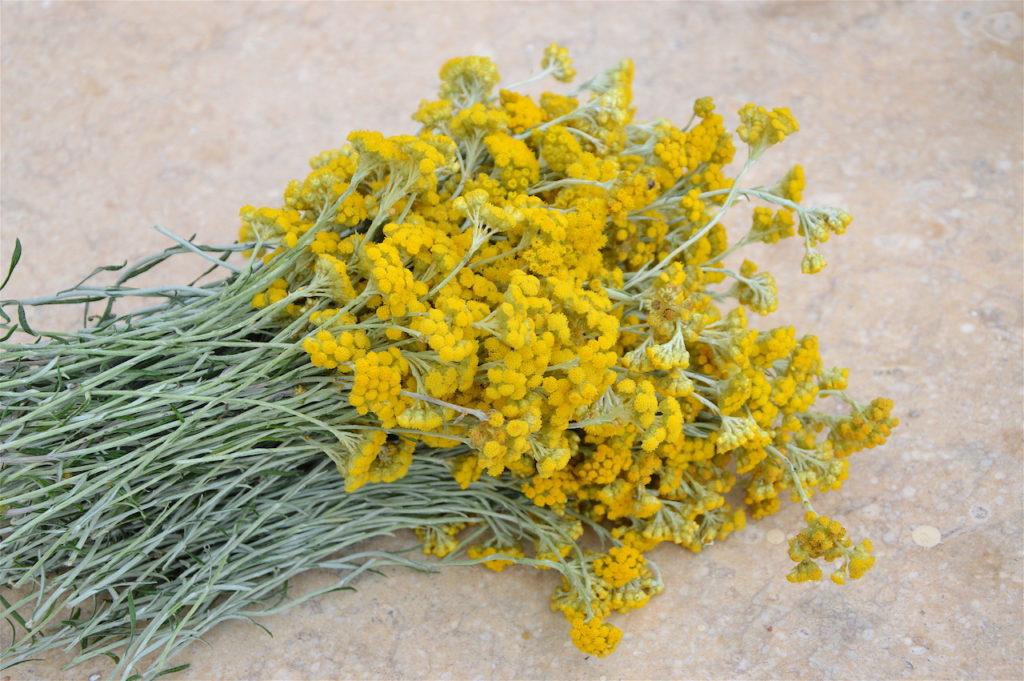
Sometimes names are funny, so to say we have a Greek-Italian helichrysum here, considering the scientific name Helichrysum italicum and the growth area Greece. But well, the geographical indication is still not considered with that much respect, and sometimes it is sort of (mis)used to attracting people with fancy names in the ingredient lists. There are far more to see, and oftentimes, other things as plant identification can get you into confusion. I could apologise in advance for the way I use names in this writing, but I generously gave myself permission to take my accuracy a little easy. Beyond the artistic nature of my explorations, my excuse is partially covered by the contradictions and inaccurate descriptions and statements that I keep finding in multitude of works and books. Of course, it is important to take serious things seriously, but also to bring tolerance into practice. From the diversity of the world comes a large variety of names for the same or similar plants linked to their local habitat, the botanist who registered them, and so on. The Sisyphus unification work of harmonising individual research undoubtedly brings about a common language and many advantages. Yet, it’s just a sort of self-deception to believe we are able to keep up with nature and fool ourselves with the capacity of an almighty presence everywhere – continuously, simultaneously and instantaneously.
The genus Helichrysum is known to count over 500 spieces in the world, and the ones in Crete include Helichrysum heldreichii, Helichrysum italicum ssp. microphyllum and Helichrysum stoechas ssp. barrelieri. Visuals and descriptions of botanical publications, even plant watch at the Botanical Park of Crete makes labelling of the local varieties of this beautiful highly aromatic curry plant questionable.
In any case, our nose knows when a good plant comes across our way. And finds its way to the distillery. Being educated in yield expectations, and knowing that Helichrysum’s essential oil yield is typically very low (and reciprocally, the price is high), I launched a distillation with my 30-litre cauldron with the purpose of distilling for its aromatic water. Using the method of water (also called hydro-) distillation, the plant parts are placed into the water-filled spherical still, and we left them for a few hours before starting the process of distillation. We go on for several hours of work, and finally close the gas and the day with rather pleasing results. The hydrolat has a slightly bitter taste, and we experience it as a delicate and soft aroma with a sweet tendency.
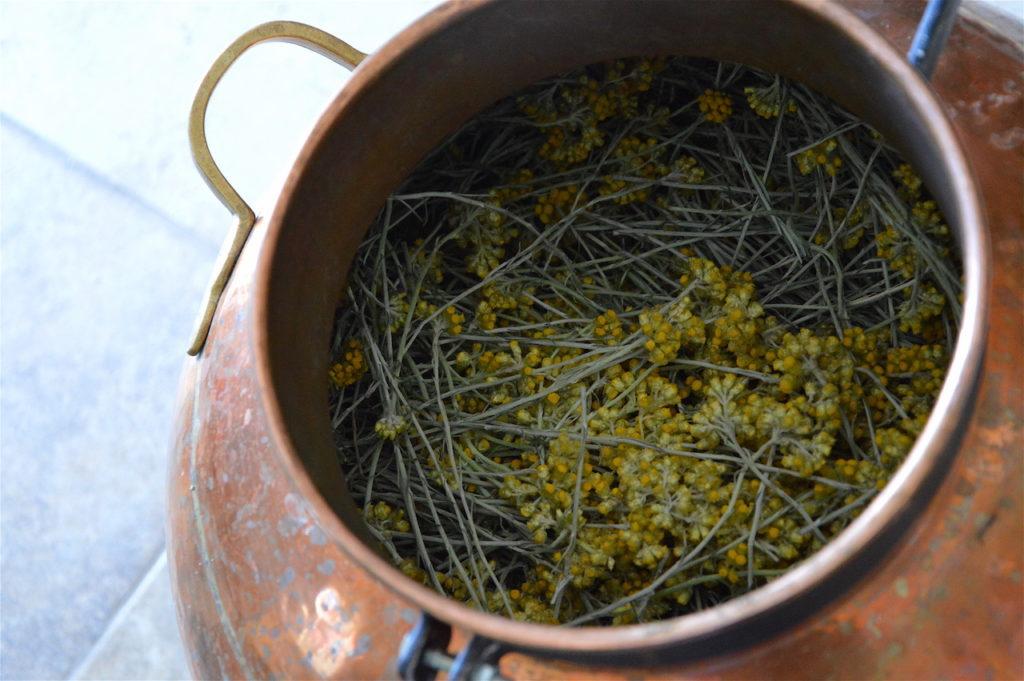
In November the same year, I had the opportunity to do another Helichrysum distillation, this time the plants after blooming, yet still stunningly aromatic with nice and soft touch. Living in a happy, organic environment, the shrub is growing on Leonidas’ farm, a dear friend taking care of his lush land with so much love, care and expert wisdom that really worth spreading. Whenever I manage, I off to go to join them out there, even helping a little here and there. I had a chance to contribute to the creation of new raised vegetable beds, planting small plug plants, gathering of pruned olive branches, and of course, eating together with the family. I am honoured we share that sort of friendship which is open, welcoming and accepting, regardless of how often or sometimes how rare we see each other. Not only the special perception, but a magnificent perspective is offered from the small family estate, with a wonderful endless view of the Cretan landscape and its rich variety of vegetation. The helichrysum that we had harvested from Leonidas’ land gifted us all the goodness in the aromatic water. Most of the plants were put in water and one part in the column tower dancing nude in the uprising steam. As it is often experienced with aromatic molecules travelling through the hot air all the way to the outlet tube of the distiller, some of these Marathon messengers bring along the fragrant news in the air, way before the first drops arrive. Perhaps, as a result of the mixed distillation and getting some of the best of both worlds, with the added advantage of several hundreds of hours of sunshine over the past months, this November distillation was just like an incantation, making a spell with high intensity aromatic water.
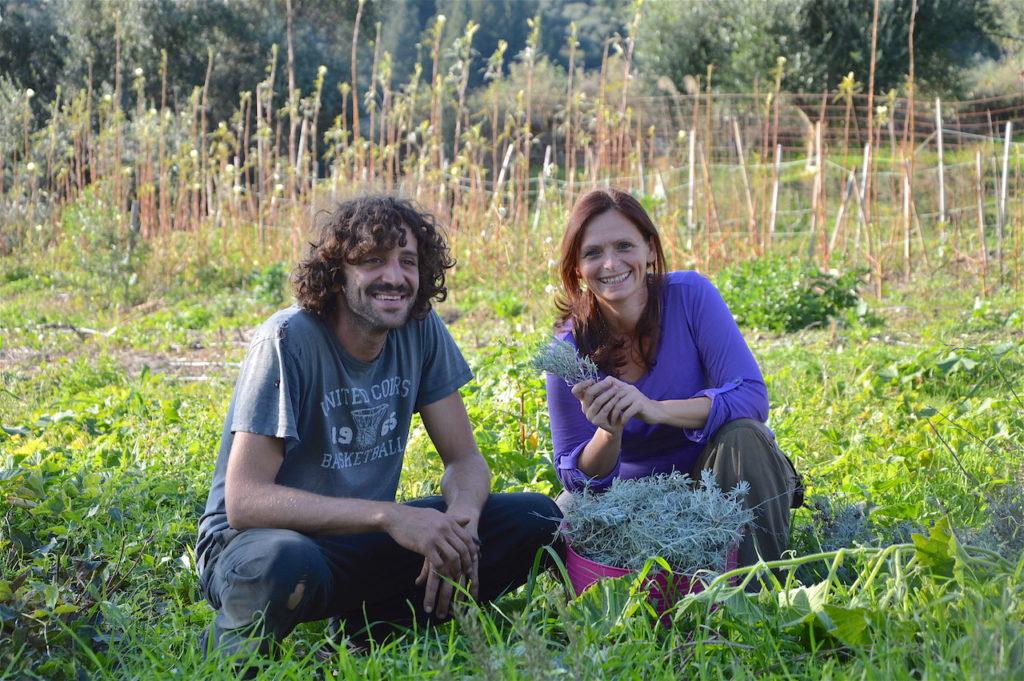
Aromatic daycare
Since I have a wide selection of aromatic waters from my own distillations, I keep using them daily in all sorts of ways. Certainly, there are times when one or another gets special attention, yet Helichrysum has been chosen the one companion that is there for me when I open my eyes in the morning and when I go to bed at night. Although often I get tempted to get a kiss on my cheeks from cistus or wild carrot, but basically, it is the Immortelle hydrolat that I use as a facial spritzer. It serves as a face wash, a refreshener, a moisturiser, and also as a soothing, regenerating tonic for my skin, whenever I spend a few hours out there in the burning sun. During the summer, I carry a small bottle with me for situations when a quick fix for pre- or post-treatment is needed for my own skin, or for anybody else. It does make a difference. I have also made great blends with helichrysum, such as an eczema spray for someone, adding also lavender, rose geranium and chamomile hydrolats. The affected area on her finger was red, blistered and cracked. Spraying it hourly with the mixture brought relief and visible success, in two days the symptoms were less severe, itching decreased, redness disappeared, blisters retreated and 50% of the scars healed. Needless to say, due to the complex nature of such an issue, it requires more comprehensive and long-term treatment, however, the initial results can give us an idea about the important role aromatic waters can play in the protocols of alternative and complementary natural treatment packages.
Infusions and tinctures
Making infusions with Helichrysum is also very nice and requires attention. Even if just a tiny part of the plant remains uncovered by the vegetable oil, you can say goodby to your plans as mold would develop very quickly. I know that from experience as well, as I had to dispose my expensive high-quality argan oil together with the beautiful plants. What happened is that in the process of filling up the glass container I realised I didn’t have enough of the base oil to fill up the jar. However, I thought I would go into town and get the missing part covered the same day. In the end, things played out differently, and I happen to forgot about finishing with the other bit of that half-full glass… Of course, I could have also used vegetable oil at hand, for instance jojoba, almond or olive oil. In any ways, when the process is successful, we get a great rich raw material that can be applied directly to the skin, or added to creams, and other products.

In addition to oil-based infusions, I also make preparations with alcohol for botanical perfumes. Herbs put into alcohol more willingly give their colour, aroma and other valuable properties to the menstruum. To me, a good perfume with true botanical ingredients is also medicine that supports our well-being on multiple levels. The rule also applies here: different plants collected from different places at different times will bring different notes and qualities. In case of my helichrysum alcoholic extract from 2018, there was some inspirational synchronicity, as around that time a paint manufacturer just announced the colour of the year, the warm, mellow Heart Wood. My tincture started just like this soft, slightly spicy, mild and warm, powdery, woody material. Later, the colour deepened, and the fragrance moved towards a stronger, herbal character of bitters, and got beautifully aged over time.
Essential oil applications
Although I do not have the still capacity to distill helichrysum essential oil of my own, but for my aromatherapy practice, I use the highest quality sources from the Mediterranean region. There I have also worked with bottles from Corsica and Croatia, while Greek producers are yet to be explored. Besides its warm, woody and spicy notes, the scent of Helichrysum reminds me of a certain crunchy Neapolitan wafer stuffed with some cream, a sweet delicacy of my childhood. From the childhood that I brought with me regular herpes outbreaks on my lips and that caused some bitterness through life. My mother used to say always that it was due to some meals I ate with great passion and joy. Over the decades, however, I noticed that subtle subconscious anxiety and tension greatly contributed to the unexpected appearance of the awful sores and blisters. Officially, it is the weakened immune system that gives way to the activation of the herpes virus. Nevertheless, I would rather say that this question is more complex, and sometimes even with strong immunity, psychological influences just enter your life – without any politely note or excuse – and turn everything upside down. Now, who is triggered by what, that is also a matter of individual sensitivity.
Anyhow, I have certainly had the opportunity to test out the nature of herpes simplex and to develop my own complex formula for that. In addition to mapping emotional causes, the right synergy of lip-care oil blends proved to work as an effective help. My herpes healing balms and oils include lemon balm (Melissa officinalis) and helichrysum as the most powerful ingredients, and they made it possible to reduce the severity, extension, healing and regeneration time in a great extent, for me and for others.
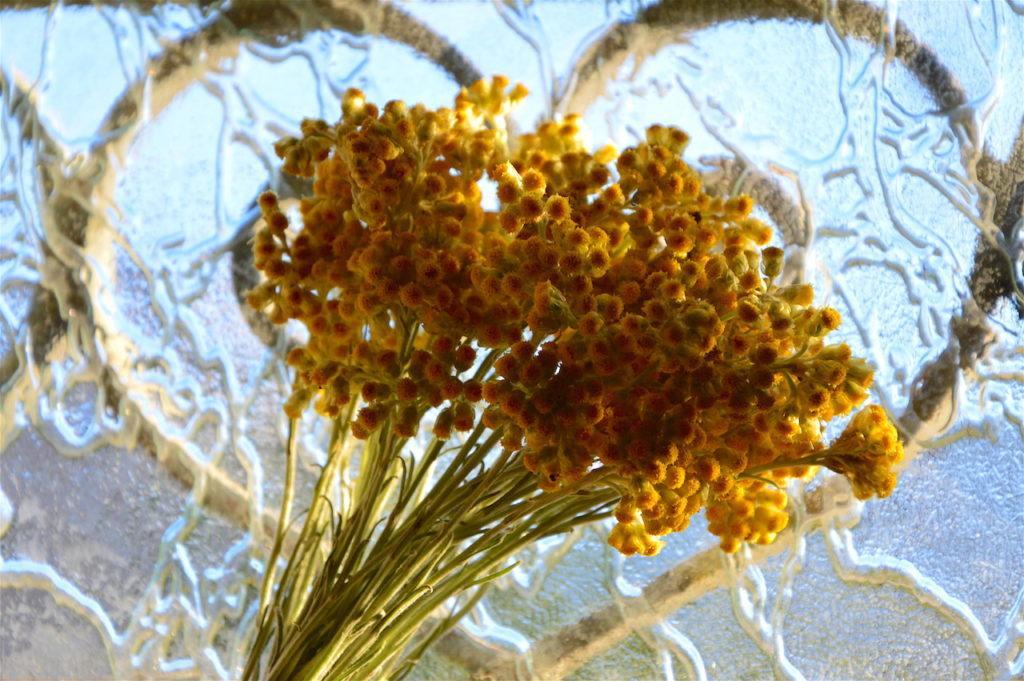
Depth of the regenerative capabilities of helichrysum, with various uses of its essential oil, hydrolat and other extracts deserves a standalone piece of detailed work. Elisabeth Ashley, The Secret Healer has already dedicated some 200 pages to this in her book titled ‘Helichrysum For The Wound That Will Not Heal’. That piece is on my wishlist for botanical and aromatherapy books to read. In the meantime, I forgive my humble wisdom seeker self, for all the books that have yet remained uncovered and for all the days when I tend to feel my hunger to be desperately unfulfilled. Perhaps, working with Helichrysum as the symbol of Immortality may be the cure for reconciliation and transforming surging inner flames into shining light.
 The article was originally written for and published in the issue 2019/2 of Aromatika Magazine, an online publication in Hungary to support holistic living, the practice and professional education of aromatherapy, phytotherapy, naturopathy and related subjects. My special thanks and gratitude goes to Gergely Hollódi, editor-in-chief of this beautifully constructed aromatherapy periodical, for his always encouraging support. Hope you enjoy the English version in this post.
The article was originally written for and published in the issue 2019/2 of Aromatika Magazine, an online publication in Hungary to support holistic living, the practice and professional education of aromatherapy, phytotherapy, naturopathy and related subjects. My special thanks and gratitude goes to Gergely Hollódi, editor-in-chief of this beautifully constructed aromatherapy periodical, for his always encouraging support. Hope you enjoy the English version in this post.
References
Mailhebiau P. (1995). Portraits in Oils: The personality of Aromatherapy Oils and Their Link with Human Temperaments. Saffron Walden: C.W. Daniel.
Fielding J., Turland N. (2005). Flowers of Crete. Royal Botanical Gardens. Kew. UK.
Shutes J, Hollódi G. (2014). Aroma 201, Aromaterápiás mesterkurzus. Aroma Botanica.
Hollódi G.: (2013). Testre Szabott Illatok. Aromaterápiás vetőkártya. Aroma Botanica.
Papiomytoglou V. (2006). Wild Flowers of Crete. Mediterraneo. Greece.



